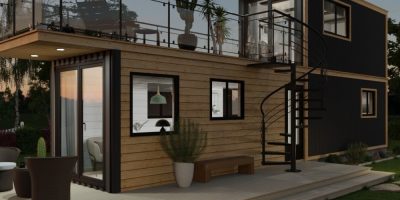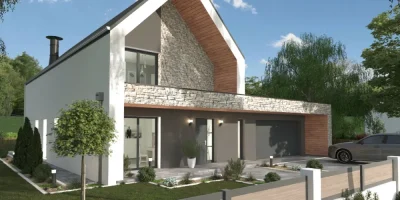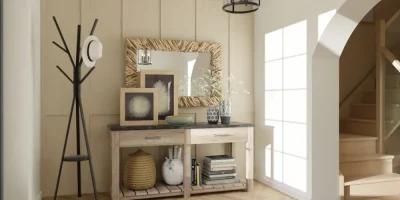A sunroom addition can completely transform how your clients live in and enjoy their homes — but only if it’s designed correctly.
Whether they want a peaceful morning retreat, a year-round family room, or just more space, the right sunroom design can make all the difference.
In this guide, you’ll find expert-backed design tips, cost insights, and layout ideas to help you create sunroom additions that impress clients and help you land more jobs.
Key Takeaways
- There are five main types of sunroom additions, each with different structural needs, climate performance, and cost profiles.
- The biggest cost drivers include seasonality, materials, square footage, HVAC needs, and how the sunroom integrates with the home.
- Thoughtful sunroom designs enhance indoor-outdoor flow, boost natural light, and add flexible, livable square footage.
- Cedreo makes it easy to design sunrooms with accurate lighting, 3D views, and professional floor plans in hours, not days.
Why trust us? Here at Cedreo, we’ve got over 20 years of experience working with housing pros in the home design space. We know what it takes for home builders, contractors, and designers to create sunroom addition plans that land them more jobs!
Types of Sunroom Additions
Before you start designing, it’s important to understand the key types of sunroom additions and what makes each one unique.
Screen Rooms (Patio Enclosures)
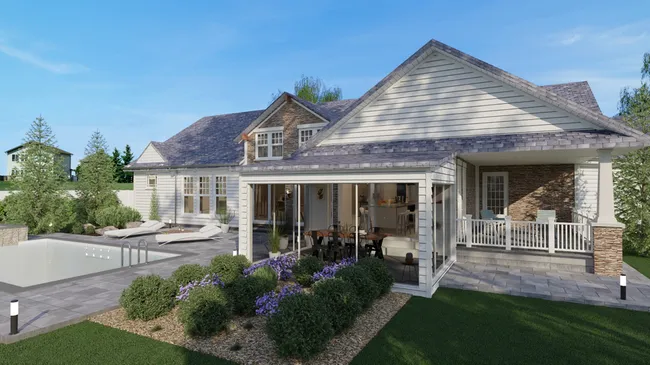
Screen rooms (also commonly called “patio enclosures”) are open-air enclosures with mesh panels instead of glass. These protect from bugs and light weather without sealing off the space.
Pros:
- Most affordable sunroom option.
- Great airflow and connection to the outdoors.
- You can easily build them on existing porches or decks.
Cons:
- Patio enclosures aren’t usable year-round or in bad weather.
- No climate control or insulation.
3-Season Sunrooms
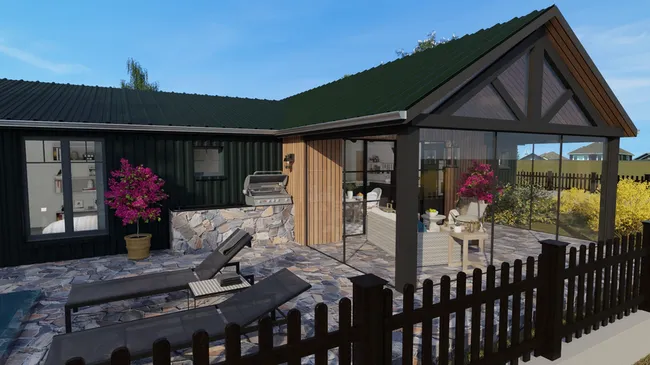
Three-season sunrooms use lightweight framing and single- or double-pane glass to provide a light-filled space for spring, summer, and fall.
Pros:
- Less expensive than four-season rooms.
- Quick to build with more material options.
- Ideal for mild climates or occasional use.
Cons:
- Uncomfortable during winter in most regions.
- Limited insulation and no HVAC integration.
4-Season Sunroom Additions
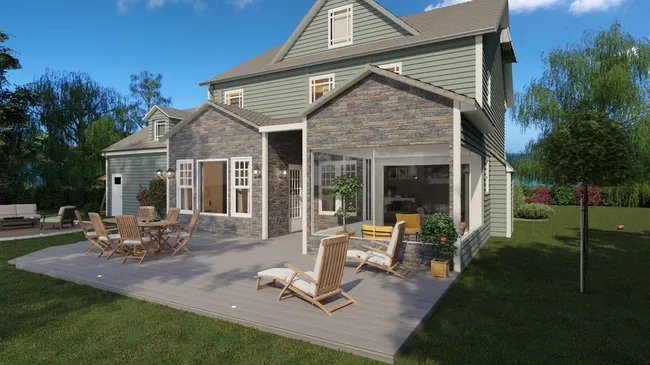
Four-season sunrooms are fully insulated and climate-controlled. This lets homeowners use the sunroom year-round, just like any other room in the house. To achieve the proper insulating value, four season rooms will commonly have knee walls, double or triple-pane glass, and insulated roofs.
Pros:
- Four season rooms add livable square footage that is usable in all seasons.
- The four season extra space increases home value and resale appeal more than screen rooms or three season sunrooms.
- Supports multiple uses — from living rooms to offices.
Cons:
- Higher cost due to insulation, HVAC, and materials.
Solariums and Conservatories
Solariums and conservatories (also called garden rooms) feature floor-to-ceiling glass and often include glass roofs. These types of sunroom additions maximize sunlight and dramatic views.
Pros:
- Stunning aesthetics and panoramic light.
- Perfect for plant lovers or scenic properties.
Cons:
- With so much glass, solar heat gain and heat loss can be hard to control.
- These are often just as expensive to build as four season sunrooms because of the complex glass and engineering.
Prefabricated Kit Sunrooms
Prefabricated sunrooms are modular kits that come pre-engineered and are assembled on-site. Kits like these are typically faster to build and at a lower cost.
Pros:
- Fast installation and lower labor costs.
- Often more affordable than custom builds.
- Great for three-season or basic four-season use.
Cons:
- Limited design flexibility and customization.
- May not match the home’s exact style or structure.
How Much Does a Sunroom Addition Cost?
Sunroom addition costs vary widely based on type, size, materials, and how it integrates with the home. For most projects, expect costs like these:
- Screen Rooms: $5,000–$20,000
- 3-Season Sunrooms: $15,000–$50,000
- 4-Season Sunrooms: $30,000–$120,000+
- Solariums/Conservatories: $15,000–$90,000+
- Prefab Sunrooms or Sunroom Kits: $3,000–$30,000
- Price per square foot can range from $50 to $500, with the average price being $100-$350 per square foot.
Key cost drivers include:
- Square footage
- Glazing type (single vs. double or triple-pane)
- Foundation complexity (slab, crawl space, deck, or pier)
- Roof materials (glass, polycarbonate, wood trusses, or insulated panels)
- HVAC integration (ductwork vs. mini-split systems)
- Site preparation and permits
- Interior finishes and lighting
Budgeting Tips: Reduce Costs Without Sacrificing Style
- Build on an existing patio or structurally sound deck to avoid new foundation costs.
- Choose double-pane Low-E glass instead of triple-pane for solid energy performance at a lower price.
- Use solid insulated roofing panels to cut labor installation costs.
- Simplify the shape. Rectangular rooms are more cost-effective to frame and finish.
- Skip full HVAC integration in favor of a ductless mini-split or ceiling fans in mild climates.
6 Sunroom Addition Design Considerations You Can’t Afford to Miss
Designing a sunroom that looks great and performs well starts with smart planning. Here are the key design factors that make all the difference.
Take Full Advantage of Natural Light
The magic of a sunroom starts with how it captures light. But it’s not just about big windows, it’s about placing them correctly to get the best light, comfort, and views all year.
Orientation matters: Consider your geographic location. The following is best for locations in the northern hemisphere.
- South-facing: Great for winter warmth but may need shading in summer.
- East-facing: Offers bright, gentle morning light. Perfect for breakfast nooks or plant rooms.
- West-facing: Delivers strong afternoon sun that can overheat the room if not shaded properly.
- North-facing: Gives soft, indirect light that works well for home offices or studios.
Practical design tips to take advantage of natural light:
- Install operable clerestory windows near the ceiling to release trapped hot air.
- Use roof overhangs or pergolas to block high-angle summer sun while allowing in winter rays.
- Frame windows to highlight key outdoor features like gardens, water views, or trees.
- Use Cedreo’s 3D visualization software to adjust the sun’s orientation to preview exactly how natural light will enter the sunroom.
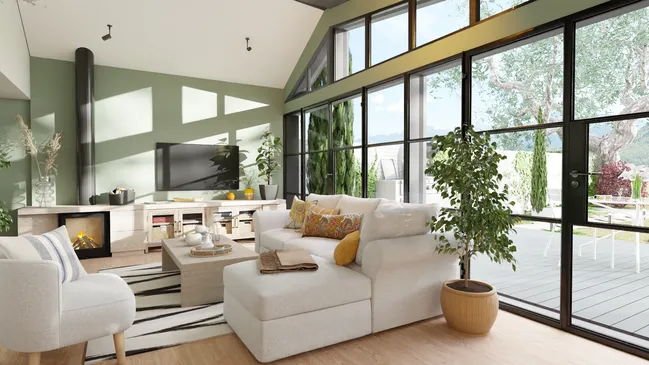
Choose the Right Materials
Choosing smart materials early in the design process saves time, money, and future maintenance headaches.
Best picks:
- Framing: Thermally broken aluminum or reinforced vinyl has excellent cost-to-performance ratios. Many four season additions are stick-built with traditional wood framing.
- Roof panels: Use structural insulated sunroom roof panels for climate control and easy installation.
- Flooring: Go with durable, water-resistant surfaces — tile, vinyl plank, and polished or stained concrete floors are popular choices.
Window Types and Configurations
The right windows do more than brighten the room. They help regulate temperature and improve energy efficiency.
Popular options:
- Combine fixed and operable windows to balance air flow and visibility.
- Use awning windows higher up for passive ventilation without weather intrusion.
- Consider window grids or shapes to complement the home’s architectural style.
Indoor Outdoor Transitions
Sunrooms should feel like a natural connection between indoors and out. Start by planning wide doorways, ideally with glass panels, to bring in light and views even when closed. It’s also a good idea to choose materials and colors that blend interior finishes with the outdoor landscape.
Design considerations:
- Try to match the flooring height with the main home to avoid awkward step-ups.
- Consider using retractable or folding glass walls that, when open, create a seamless transition between the outdoors and the sunroom space.
Interior Design and Layout
Function should drive layout, but good design ensures it looks intentional. Avoid cluttering the space so that light and views remain the focus.
Tips for success:
- Select UV fade-resistant fabrics for cushions and curtains.
- Add layered lighting (ambient + task) for evening use.
- Place larger furniture pieces against solid walls to keep windows unobstructed.
- Use Cedreo floor plan software to easily test different 2D floor plans until you get the layout just right.

Smart Integration with the Existing Home
When a sunroom matches the home’s architecture, it enhances both function and curb appeal.
Don’t forget:
- If you can’t use the same finishes in the sunroom as the existing home, make sure your contrasting design choices look intentional.
- Use Cedreo to model the home addition in 3D alongside the existing home to troubleshoot proportions and flow before construction begins.
Leverage Cedreo for Better Sunroom Designs
Sunrooms are all about light, views, and flow — and Cedreo makes it easy to bring those elements to life before construction begins. Check out these three ways Cedreo can help you do that.
Visualize Accurate Lighting
With Cedreo’s 3D rendering tools, you can simulate daylight and sunset lighting to see exactly how natural light will flow through the sunroom. This helps you avoid glare, identify dark spots, and optimize window and skylight placement. For home builders and designers, it’s a powerful way to ensure your plans deliver the bright, welcoming spaces clients expect.
Planning the Glass Features
Cedreo’s glazed area orientation table makes it easy to plan where and how to use glass in a sunroom. You can experiment with different wall layouts, window heights, and glass-to-wall ratios to balance light, insulation, and outdoor views. For pros designing four-season rooms or solariums, it’s a simple way to get glazing right.
See the Sunroom Throughout the Year
Use Cedreo to view your sunroom design in every season. See it in a snowy winter scene, a leafy fall, or bright spring. This seasonal context helps clients visualize how their sunroom will function and feel all year, and makes it easier to justify four-season upgrades.
Sunroom Addition Ideas
Need fresh inspiration? These standout concepts help homeowners get more living space, function, and enjoyment from their sunroom additions.
Backyard Garden Escape
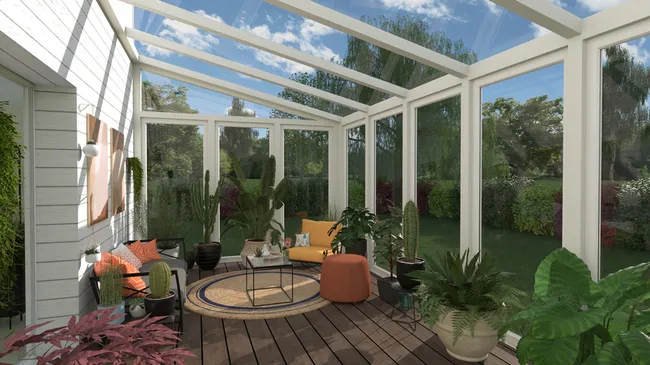
This new sunroom doubles as a garden room with built-in planters and natural light for year-round growing. It’s a great idea for homeowners with a green thumb. Add moisture-resistant flooring and proper ventilation for a durable, low-maintenance space.
All-Season Dining Pavilion
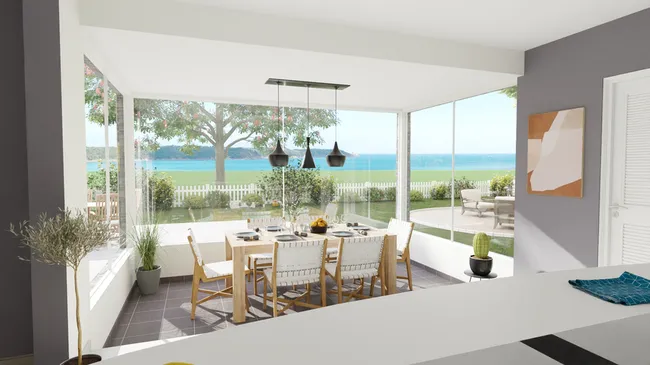
A four season sunroom with vaulted ceilings and panoramic access to the kitchen creates the perfect space for family meals and quality time. Most homeowners love the added benefits of year-round comfort, especially when paired with a mini-split system. Add double doors or a retractable wall for easy access to an outdoor kitchen grill area.
Sunroom Home Office with a View
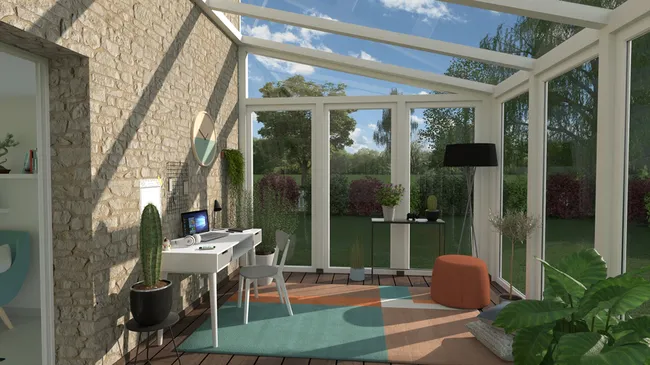
This quiet, light-filled room offers additional space for working or creating. Four season rooms like this provide more usable space for homeowners.
Design Your Next Sunroom with Cedreo
Designing the perfect sunroom means balancing light, comfort, and cost, and Cedreo helps you get it right from the start. With fast 2D and 3D floor plans, daylight simulations, and client-ready presentations, Cedreo makes it easy to visualize and sell sunroom designs in less time.
Start your next sunroom project with Cedreo — try it FREE today.
Sunroom Addition FAQs
How much do sunroom additions cost?
Sunroom additions typically cost between $15,000 and $100,000+, depending on type, size, materials, and whether it’s a three- or four-season room.
What is used for a sunroom roof?
Common sunroom roof materials include solid insulated panels, polycarbonate, and glass, often supported by vinyl or aluminum room framing for durability and energy efficiency.
Are sunrooms four season rooms?
Some sunrooms are built as four season rooms with full insulation, HVAC, and thermal glass, while others are three season rooms designed for spring through fall use only.
How long does it take to add a glass sunroom addition?
Most glass sunroom additions take 2 to 6 weeks to complete, depending on complexity, materials, weather conditions, and the experience of the sunroom contractor. Some patio enclosures that come as kits can be built in just a few days.
Does a four season room addition add value to a home?
Yes, a four season sunroom addition often adds value by increasing usable living space and boosting curb appeal, especially when designed with quality materials and finishes.
Is it cheaper to build a sunroom or an addition?
A sunroom is generally cheaper than a full home addition due to simpler construction, fewer plumbing or electrical requirements, and fewer structural changes.
Are prefab sunrooms cheaper than custom-built sunrooms?
Yes, prefab sunrooms typically cost less than custom builds and install faster. However, they usually offer fewer design options and require careful planning to match the existing porch or patio.
Does the sunroom addition on the back of a house need a foundation?
Yes, most sunroom additions require a foundation, although some patio enclosures or aluminum rooms can be built on existing slabs or decks with proper additional structural support.
Can you use single pane glass in sunrooms?
Yes, you can use single-pane glass in sunrooms, but many homeowners who choose it end up regretting it. Although single-pane glass is the most affordable option, it offers minimal insulation. That means sunrooms will be hot in summer and cold in winter.

